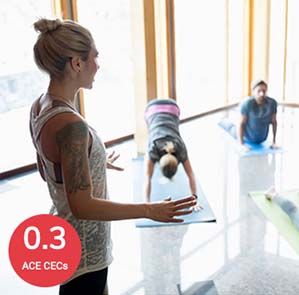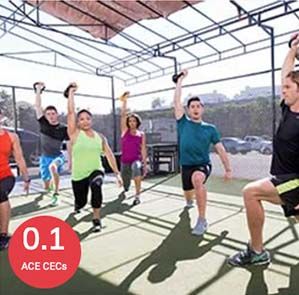
In a constantly evolving fitness industry, there are countless reasons to hold multiple certifications, from being quicker to recognize the need for modifications to offering more succinct cues, from making more money to avoiding burnout. In fact, complementary skills that carry over from being a group fitness instructor (GFI) to being a personal trainer will not only make you a more well-rounded professional, but also a more attractive job candidate to those doing the hiring.
Jan Schroeder, PhD, professor in the Department of Kinesiology at Long Beach State University, teaches a course at the university entitled “Theory and Analysis of Group Exercise Instruction” and leads several group fitness classes in the community each week. She says that holding multiple certifications is growing more commonplace, and that from a hiring perspective it’s becoming increasingly valued: “Talking with other people in the industry, they tell me that if they can have somebody who does both, that person is so much more valuable to them than somebody who can only do one or the other.”
That value derives from something more than simply being versatile in the fitness facility. It also stems from skill sets that carry over from the group fitness space to one-on-one training sessions. So, what is it about being a GFI that makes someone a better trainer?
You’re Quicker on Your Feet
Kim Olige is the President and Founder of Youth Style Fitness, a Charlotte, N.C.–based non-profit organization that empowers youth development, an ACE Certified Group Fitness Instructor and Personal Trainer, and an ACE Ambassador. “I think being a GFI makes me a better personal trainer, for sure,” he says. The primary reason? Olige says he’s better able to think on the fly during one-on-one sessions because he’s honed that skill while working with groups of 20-plus kids during his weekend boot-camp classes. After that, everything feels much easier in a personal-training session, he explains.
For Olige, cueing is probably the biggest area of carryover, as having the expertise required to offer multiple cues to people at various skill and fitness levels makes it much easier to do so when working one on one.
Modifying movements for different exercisers is another valuable carryover skill. “Group fitness instructors are excellent at making modifications… quickly!” Schroeder says, snapping her fingers for emphasis. GFIs are taught how to do that very early on as part of their education and experience, whereas that might not be a focus for personal trainers. Having that skill is a great add-on for trainers, especially if they offer small-group training classes (more on that below).
You Know How to Work With Different Types of Learners
“GFIs are very good at cueing for a multitude of learning styles,” Schroeder says. Because GFIs are dealing with all types of learners simultaneously, they become adept at cueing in various ways to meet everybody’s needs. That transfers over to personal training because you might have one client who prefers a visual style of learning and another who prefers a kinesthetic style, for example, and you’ll be able to recognize that and adjust accordingly.
While that may seem like a minor consideration, imagine a new client who is debating whether to buy a package of training sessions. If you are better able to recognize their preferred learning style, adjust your cueing and communication in response, and build rapport more quickly early on, they may be more likely to feel as though your time together is meeting their needs and worth the investment. If that connection is absent, you may lose those clients who are on the fence about working with you before you feel you’ve had the opportunity to prove your value.
The Benefits of Earning a Second ACE Certification
Here is a handful of ACE-specific benefits that ACE Pros should be aware of:
- Earning a second certification fulfills the 20 hours of continuing education (2.0 CECs) you need in order to renew your first certification. In other words, becoming a certified GFI means you’ve earned the CECs required to renew your personal trainer certification.
- Holding multiple ACE certifications means you pay a discounted renewal rate for each. And, that rate goes down with each additional certification you earn. Next up, health coaching!
- CECs can be applied to multiple certifications, provided they are all earned within the defined renewal period for each certification.
If you are interested in adding a second certification and expanding your skill set, check out ACE’s Group Fitness Instructor and Personal Trainer study programs and get started now.
You Know How to Build a Community
Because personal trainers often transition from one client to the next without a break, they don’t typically focus on developing camaraderie among their clients—and they may not see the value in doing so. Think about how that contrasts with the work of GFIs, who often spend time talking to participants before and after classes and host special events where their participants get to know one another.
“Where GFIs really excel is in building a fitness community,” explains Schroeder. Personal trainers can benefit from having that skill set to boost program adherence among their clients and, as a result, their income potential. Schroeder recommends taking the last few minutes of one session and the first few of the next to introduce clients to one another, and to highlight a connection they may have.
You might also identify clients who have similar fitness levels, goals and values and form small groups. Offering a small-group session (at a discount) every other week, for example, lowers the cost for your clients, boosts your revenue and builds a sense of community that makes the experience more fun and increases social support and long-term adherence.
Speaking of fun, GFIs know how to make sure everyone in their class is having a good time. A GFI will know how to transfer the fun factor from the group environment to a one-on-one session. Things like using inclusive language and creating a welcoming and empowering space are vital.
You’re More Resistant to Burnout
Face it, one-on-one sessions can be draining. Regardless of scope of practice concerns, training sessions sometimes feel like therapy sessions as clients unload their stressors and drama. And, while that emotional work is largely absent from the group fitness space, there are only so many classes you can lead each week. Finally, and this can be particularly true for young professionals, it can sometimes feel like there is a hard cap on earning potential. After all, if you’re trading hours for dollars, that limit is real.
By diversifying your skill set and offering a combination of services, you may be able to avoid or soften that feeling of burnout that nearly every exercise professional faces at some point in their career. Stated simply, having more ways to make money adds variety to your day and may reduce the risk of burnout.
Final Thoughts
Prior to working full-time at his non-profit, Olige worked in a large gym setting, where he was just one of many personal trainers. One day, a manager approached him, asked about his ACE GFI Certification and inquired about whether he’d be interested in teaching some classes. Olige seized the opportunity to broaden his role and make some extra money.
What he soon found was that the group fitness space offered a tremendous networking opportunity. “By developing that rapport in a group setting,” he explains, “they feed off your energy and I had a lot of people pull me aside after class.” They would ask about personal training and he often discovered that the participants’ comfort level with him and his teaching style is what made personal training feel more approachable. That comfort broke down a barrier to participation.
Schroeder points out that the opposite also holds true, that inviting training clients into the group fitness room can reap benefits. It not only introduces clients to a ready-made fitness community, but also opens up the possibility of them discovering a new type of physical activity they may not have otherwise tried and offers a network of friends and social support/accountability.
At the end of the day, holding multiple certifications is about being a more complete professional. Schroeder says it best: “The more you become a more well-rounded fitness professional—having group skills, having training skills—it makes you a better fitness professional because you’re able to address a wider range of client needs. And, it’s not just their physical needs. It’s how they learn, it’s how they respond to motivational techniques and it’s how they assimilate the knowledge that you’re giving them. It gives you a better understanding of fitness and exercise principles because you’re doing it in a wide variety of ways.”
Expand Your Knowledge
Creating Impactful Group Fitness Classes – Course Bundle
Gain a deeper level of understanding of group fitness and the application of teaching strategies so you can safely and effectively guide your class participants, regardless of fitness or skill level. The Creating Impactful Group Fitness Classes course bundle will get you up to speed on effective coaching techniques and strategies so you can guide your class participants to their individual fitness goals.
How to Be a Dynamic Group Fitness Instructor
Group fitness instruction is more than developing a sequence of exercises—it’s also about engaging each participant and understanding what each person needs in order to get the most out of the class. With this course, discover how you can be your best as an instructor so you can offer inspiring class experiences, and learn the fundamental teaching principles that will enable you to teach dynamic classes. You will train your eye to view and assess compensations and good form in numerous functional movements, and you will discover how to assist people in improving these movements through correct cueing and muscular awareness. Through brilliant teaching, your classes will be engaging and motivating, keeping your participants coming back for more.
The Business of Small Group Training
How do you incorporate small group training and high intensity interval training into your business strategy? This webinar led by Steven Trotter—Assistant Director for Fitness Programs at Virginia Tech—explores the world of group training and describes how to get the most return on your investment.





 by
by 





